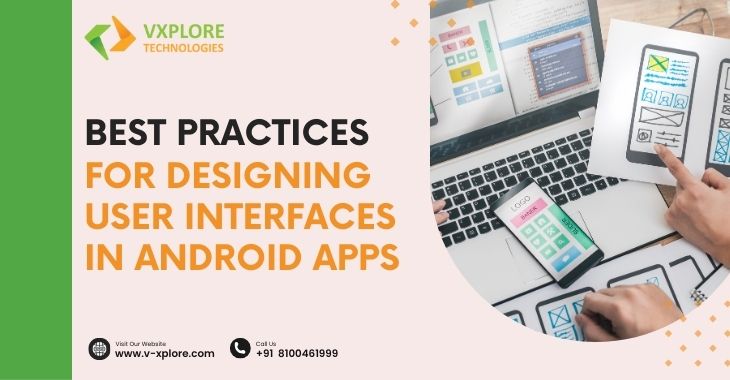The design of the user interface (UI) is essential to the success of any Android application. In addition to improving the user experience, a user-friendly and visually appealing user interface encourages user engagement and retention. However, creating UIs that work well for Android apps has requirements and obstacles. In this blog article, we’ll look at some best practices for creating user interfaces for Android apps that excite users and improve their entire app experience. If you opt to get the best Mobile App Development, you must choose a reputed Android App Development Company. In that case, you can contact Vxplore Technologies to learn the best practices and strategies.
Let’s delve into the points:-
- Understand the Material Design Guidelines
- Emphasize Familiarity and Consistency
- Prioritize Accessibility
- Optimize for Different Screen Sizes and Resolutions
- Simplify Navigation and Interaction
- Opt for Gestural Navigation and Feedback
Understand the Material Design Guidelines:
The Google Material Design principles offer a thorough framework for creating user-friendly and aesthetically pleasing Android app interfaces. Learn these rules so that your app’s UI design is coherent and consistent. Material Design strongly emphasises elements like motion, colour, hierarchy, and typography—all of which are necessary to produce a unified user experience across various Android devices.
Emphasize Familiarity and Consistency:
A user-friendly user interface (UI) requires consistency. Throughout your app, keep the vocabulary, iconography, navigation patterns, and layout all consistent. The app’s UI should be intuitive to users, and they should be able to predict the behavior of various aspects. In addition to improving usability, consistent UI elements provide users with a sense of confidence and trust.
Prioritize Accessibility:
Accessibility is a crucial component of user interface design, guaranteeing that all users, including those with impairments, can use your program efficiently. Respect accessibility norms and standards by adding screen reader support, making sure background colours and text have the appropriate contrast ratios, and captioning photos. Considering accessibility while designing your software shows empathy and inclusivity for all users and broadens its user base.
Optimize for Different Screen Sizes and Resolutions:
User interface designers face a problem with the variety of screen sizes and resolutions found in Android smartphones. Create a user interface (UI) for your app that is both responsive and adaptive so that it will work and look great across screens with varying densities, orientations, and sizes. To handle a variety of device configurations, use flexible layout approaches like ConstraintLayout and principles like responsive design breakpoints.
Simplify Navigation and Interaction:
To reduce users’ cognitive burden and friction, streamline navigation and interaction within your app. Employ user-friendly navigation patterns like drawers, tabs, and bottom navigation bars to make it easier for users to move between the various app areas. Use succinct and unambiguous microinteractions, such as feedback and animations, to improve user comprehension.
Opt for Gestural Navigation and Feedback:
Utilize Android’s innate gestural navigation capabilities, like swiping, dragging, and tapping, to design user interfaces that are simple to use yet captivating. Include gesture-based interactions for standard functions such as page swiping, element dismissal, and scrolling. In order to improve user engagement and happiness, haptic and visual feedback in response to user gestures and activities should be provided.
Conclusion
A thorough understanding of user requirements, platform conventions, and design principles is necessary to create effective user interfaces for Android apps. You may design user interfaces (UIs) that excite users and improve the entire app experience by adhering to best practices, which include knowing Material Design rules, emphasizing consistency and accessibility, optimizing for a range of screen sizes, and streamlining navigation and interaction. Remember that UI design is an iterative process, so to create UIs that connect with your audience and propel app success, keep collecting user input and iterating on your ideas. If you opt to get Mobile App Development, you must choose a reputed Android App Development Company. In that case, you can contact Vxplore Technologies to learn the best practices and strategies.




